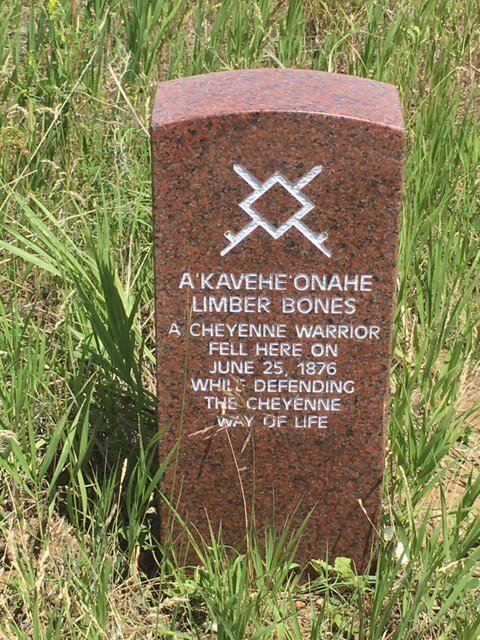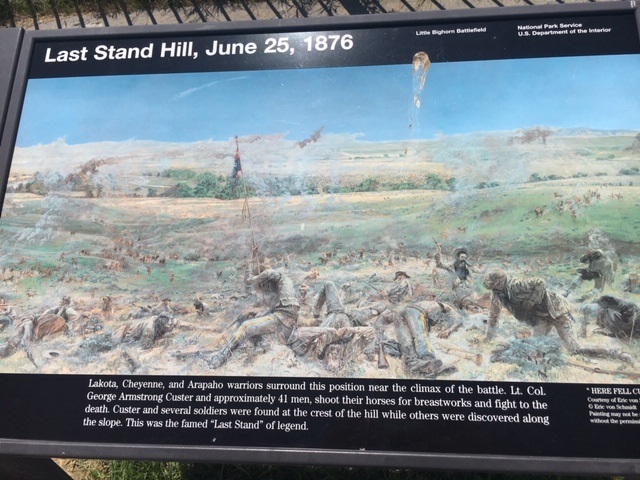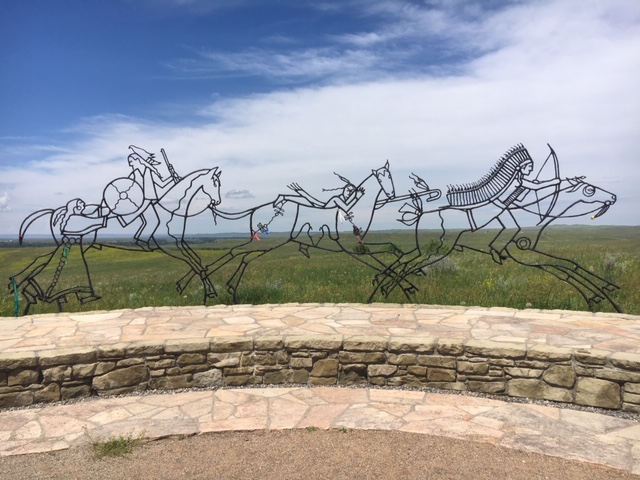
This is the 7500th blog to appear on this site since April 2011, but it seems appropriate, because of the date, to go back to the 46th which was posted on 1 June 2011 after visiting the battleground of the Little Bighorn in Montana.
Why is it appropriate? Because the battle of the Little Bighorn, Custer’s Last Stand, was fought on the 25 and 26 June 1876. If you are ever in that neck of the woods, or actually grassland because there aren’t many woods, then I recommend a visit to look at the shortgrass prairie and to look at the site of the battle, which is brilliantly interpreted on site. I revisited two years ago on 23 June 2018 when there was a lot going on locally because of the proximity of the anniversary.
It’s a battle that native Americans can celebrate because they won, although it was the last significant victory in a campaign that they were very close to losing (but let’s not get into that) and European Americans can celebrate because of the bravery and gallantry of the cavalrymen led by the charismatic, blonde and utterly flawed George Armstrong Custer (let’s hope Boris doesn’t want to emulate him as well as Churchill).
And they were European Americans as this poster from the interpretation centre shows:

There were an awful lot of Irish, Brits (and this was, of course, before the split) and Germans in the 7th cavalry at the Little Bighorn and the US-born combatants (at least the ones in blue uniforms) would have had close links with Europe at a generation or two back:

Back in blog 46 from 1 June 2011 I wrote:
Up here in Montana it feels like spring even on 1 June. The cottonwood along the rivers is just leafing up and the prairie flowers are blooming in blues, yellows and whites.
And these flowers and grasses support the bison, the pronghorn antelope (I can see one from where I am standing) and all those sparrows and Killdeers, Brown-headed Cowbirds and Western Kingbirds. Maybe because it is a lovely warm day I can also see lots of butterflies moving over the grassland – mostly one yellow species called the Pink-edged Sulphur, and many of them heading east as though they have somewhere to go.
A yellow butterfly passes by a white gravestone on the prairie, marking the spot where a young 7th cavalryman died and then passes a browner stone marking the deathplace of a young Lakota brave, for this is the battlefield of the Little Bighorn where the native Americans won a pyrrhic victory against the might of the US Government in a war that ended in defeat for their way of life.
https://markavery.info/2011/06/01/montana-prairie/

Here is the area below the memorial where the last stand was made;

… and an artist’s impression of how it might have looked back then;

It’s a wonderful thought-provoking place, not least because it is still surrounded by prairie. And the prairie is a work of art with its grazing animals, insects and birds, and the mix of grasses and flowering plants that are adapted to grazing, trampling and fire.
At the end opf my blog back then I wrote:
Were there Pink-edged Sulphur butterflies passing across the battlefield on that June day 135 years ago? Did pronghorns pause their grazing to scan the firefight below them? And was the song of the Western Meadowlark the last sound heard by some dying men? And why have the prairies been valued ever since for the blood of a few hundred men and yet not for their beauty and perfection away from where human blood was spilled?
https://markavery.info/2011/06/01/montana-prairie/
That reads a little tritely to me now – but it’s not a bad ending. It is true that there is very little ‘real’ prairie left, long- , medium- or short-grass. The Bison was almost wiped out in the years following this battle, from 40 million to almost zero, and yet it tends to be between two hundred and three hundred soldiers that are remembered here (and now, native American fallen as well) .

Whenever I visit, I doubt I’ll see it again, I think that the memorial is one to the lost prairie as well as the fallen soldiers.

I also think that the native Americans have the best memorial;

Well, that’s blog 7,500 here. Little did I know when I was standing at the Little Bighorn just over nne years ago that all that writing lay ahead of me.
How many more? It would be good to get to 10,000 wouldn’t it? I might think of stopping at 10,000. But I’m not stopping at 7,500.
[registration_form]
Never been to the USA, but the aftermath of this battle is quite interesting to me from a policing viewpoint. Sitting Bull with up to 5000 warriors fled to Canada (to what is now Saskatchewan) where he was met by the local police, Inspector Walsh and about 6 men. The conversation went something like “Right lads, if you are coming here, these are the Canadian rules” to which Sitting Bull replied “OK”. Apparently these was a close friendship between the two men after that.
Fort Walsh and the RCMP Museum near Maple Creek in Saskatchewan is another nice place to visit. In the Wood Mountain area rather than the plains you describe but it feels very lightly touched by modern society.
Lovely to read your story here and wonderful to see your pictures. We were there in 2003. The camera with all our photos fell off the bike a few days later and so we never get to look back at our visit.
A tremendously atmospheric place.
Thank you for sharing.
PS Yeah, don’t stop blogging just yet. We need you!
Lovely blog Mark, I really enjoyed reading it as I did the blogs at the time, those 9 years have flown. American’s are superb at interpretation and in their parks and reserves they are not afraid of providing copious ecological information well. In the UK info is usually poor, apparently we have short attention spans.
Thank you for revisiting your earlier blog. Its been a place in my imaginations since childhood thanks to probably the same comics that you read. I think you write well about these things and I loved your tales from America at the time. I think you’ve also ‘rescued’ your earlier ending in review.
At one time I might have tried to visit Little Big Horn myself but no more long haul flights for me, so thanks again.
I can’t remember whether I commented at the time or not, its a place I have often imagined like Bimbling and read much about. The Sicangu Lakota historian Joseph Marshall calls it ” The day the world ended” because although a victory it was the beginning of the end of the free nomadic way of life for his people. It was also the beginning of the end for their great culture hero T’shunka Witko, Crazy Horse to us, murdered at Fort Robinson the following year by the jealousy of Red Cloud and the fear of the Army. It also of course removed the last vestiges of the protection for the prairies in the north. Its hard to imagine that sea of natural grassland stretching from well into Canada down to northern Mexico and from the Mississippi to the Rockies, with so little of it left now.
Congratulations on reaching 7,500. Unfortunately the effects of what you have written are un-quantifiable, but no doubt very extensive. Standing up for nature! It badly, badly needs it.
Do not think of stopping blogging, this country’s wildlife is in desperate need of more like you not one less.
Almost everyone feels exasperated at what various wildlife? authorities are allowing to happen.
on a lighter note if you see something really strange in my comments perhaps you could delete or alter. Find this tablet really difficult and it seems to alter things which I sometimes miss even when I always try and read before sending.